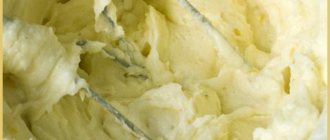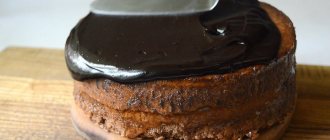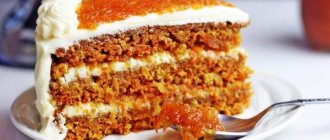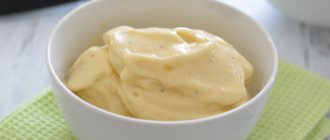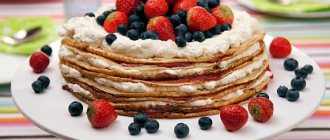What is marshmallow
Marshmallow (or chewing marshmallow) is an airy marshmallow consisting of sugar, gelatin and water, which during the cooking process turn into a soft, sweet “sponge”. The sweetness got its name thanks to marshmallow, which was used as a thickener instead of gelatin.
The iconic American delicacy has not yet become as popular among our sweet tooths, but in our stores you can already find this confectionery product of different sizes, colors and shapes.
This sweetness can be eaten simply like candy, fried over a fire, added to hot cocoa, and used to decorate sweet products.
In the decoration of confectionery products, chewing marshmallows are used to decorate cakes and cupcakes as simply beautiful elements. It is also the main ingredient in a material used to cover the top and sides of cakes called fondant.
How to melt marshmallows correctly
It is not difficult to recreate the marshmallow itself and the sweet paste for edible modeling at home. All recipes for this mastic are united by one process - melting marshmallows.
There are three ways to do this correctly:
- In the microwave. Marshmallows are placed in a glass or other bowl, the use of which is acceptable in devices of this type, and heated at maximum power for 20 - 30 seconds.
- In the oven. If you don’t have a microwave oven, you can melt the marshmallows in the oven with the heat turned on at the minimum level. An increase in sweetness in volume indicates its readiness for mixing with powder.
- In a steam bath. An effect similar to the previous two methods can be achieved if you gradually heat the chewing marshmallows in a container over steam, however, in this case the process will be longer.
Tips and tricks when working with mastic
Many articles have been written and more than one video has been shot about how to make marshmallow mastic. But not everyone knows some tricks that will make the cooking process more comfortable.
- Before stirring the heated candies, grease a spoon or spatula with vegetable oil (a small amount). Then the mixture will not stick so much.
- Before decorating the dessert, the mastic should be allowed to “rest.” Let it sit for 24 hours before you use it. This will improve its structure and it will become more flexible.
- The mastic will become very aromatic and tasty if you add a pinch of vanilla to the mixture at the stirring stage.
- Use gloves when painting the mixture. Then your hands will remain clean.
- Do not store desserts decorated with fondant in places with high humidity. She is afraid of water.
- Do you melt candy in the microwave? Watch the time very carefully. If you overheat them, the mastic will be lumpy and spoiled. And nothing will save her. It’s better to put the mixture on for two seconds several times, and the marshmallow will remain good, than once for thirty, but ruin the entire product.
Marshmallow mastic - basic recipe
The basic recipe for marshmallow mastic includes the following components:
- 90 g chewing marshmallows;
- 5 ml lemon juice;
- 8 g butter;
- 105 g powdered sugar;
- 45 g corn or potato starch.
Preparation stages:
- Combine “marmyshki”, soft butter and lemon juice in one container and set to melt in any of the available ways.
- Mix sweet powdered sugar with starch and sift. To prevent the mastic from tearing during work, it is mixed with finely ground powder. For the same reason, it is preferable to use corn starch rather than potato starch.
- When the candies have melted, stir the mixture until smooth, sift the sugar-starch mixture into it in several additions and knead the sweet dough. The mixture should be kneaded until it becomes plastically thick and has a slight gloss.
Before use, it is recommended to keep the paste in the refrigerator for a day.
If you want to paint all the mastic one color
If your idea for decorating a cake involves mastic of only one color, then it is best to color it at this “liquid” stage.
You can use dry food coloring or gel. The fact is that when the mastic is liquid, the color will be distributed much better and will be uniform without much effort on the part of the confectioner.
This same step is great for adding butter and flavorings. You can drip, for example, almonds, strawberries, cherries, vanilla, coconut.
Decorating cakes with marshmallow fondant would be incomplete without the use of dyes. They are able to bring the wildest ideas into reality, and the dessert will become not just beautiful, but a real work of art!
With powdered sugar
In the sweet mass for modeling and covering cakes, chewing marshmallow plays the role of a binding component for the loose base, which is most often powdered sugar. Both ingredients are very sweet, and their resulting sweetness will not be to everyone’s taste, so it’s worth trying to make edible plasticine from powdered sugar, which will be easy to work with, and the decor from it will delight you with its taste.
List of required ingredients:
- 100 g marshmallows;
- 5 – 10 g butter;
- 35 g corn starch;
- 55 g milk powder;
- 165 g powdered sugar.
Cooking technology:
- Pour starch, dry milk concentrate and powder into one container. Stir the mixture well with a whisk and pass through a fine-mesh sieve.
- Heat marshmallows with a small piece of butter until the marshmallows increase in size in a microwave oven or in a steam bath.
- Knead the melted treat and dry ingredients into a sweet dough.
After resting for half an hour, tightly wrapped in film, the mixture is absolutely ready, both for covering the cake and for creating sweet floral arrangements or figurines.
A simple option for beginner cooks
Cooks taking their first steps in confectionery experiments can use a simple version of a sweet paste based on chewing marshmallows, which is prepared from only three components:
- 100 g marshmallows;
- 5 ml lemon juice (or a few citric acid crystals dissolved in water);
- 220 – 250 g fine powdered sugar.
How to make mastic from marshmallows:
- Place marshmallows in a bowl that can be used in a microwave oven, pour in lemon juice, and put it all in the microwave operating at full power.
- When the marshmallows have melted enough, begin to stir in the powdered sugar. We do this first with a spoon, and then move on to kneading with our hands. Here, as when working with dough, different amounts of powder can be used, the main thing is to achieve its smooth and plastic state.
- Pack the mixed mastic in cling film and let it rest for half an hour in the cold. Then you can start using it for its intended purpose.
How long do mastic jewelry dry and store?
Do you know why confectioners are so attracted to mastic? Why haven’t they cheated on her for years now? We will tell you why marshmallow mastic is so remarkable. Decorations from it can be prepared in advance. Not one day before the celebration, not two, or even a week. This is probably why the masters of confectionery art loved it so much.
The drying time for mastic jewelry depends on the weight of the figurine. If it is, for example, a small rose with thin petals, then two days will be enough for it. If this is a large figure of the bride and groom, then even a week will not be enough for complete drying. On top, the decoration will, of course, be dense and hard, but inside it will still be soft.
Decorations made from homemade mastic can be stored for up to two months in a dry, dark place. Can you imagine how convenient this is? You can make the necessary flowers and figures in advance, and then simply attach them to the dessert.
Homemade chocolate mastic from marshmallows
Adding chocolate to chewing marshmallows helps to obtain a fairly plastic mass. In addition, chocolate immediately colors the mastic in a beautiful brown (chocolate) color. For this type of mastic, dark, milk or white chocolate is perfect.
Proportions of ingredients for one serving of marshmallow chocolate:
- 50 g marshmallows;
- 100 g chocolate;
- 100 g powdered sugar;
- 20 g butter;
- 30 ml milk;
- 2.5 g citric acid.
Sequence of actions:
- Chop the chocolate into small pieces, add marshmallows, butter and pour in citric acid dissolved in milk. Place these products in a steam bath and melt.
- Remove the mixture from the stove at the first sign of melting of the chocolate. Add powder in small parts and knead the mass until elastic. At the end of cooking, transfer the mastic to a table dusted with powder and knead it like dough.
For a richer chocolate color, at the initial stage of kneading, part of the powdered sugar can be replaced with cocoa powder.
How to make mastic for covering a cake
The cake benefits in beauty and taste when completely covered with a delicate and thick paste. Covering the surface of the cakes will not be difficult if you choose the right mastic recipe.
Sugar mastic recipe
Sugar mastic is suitable for decorating a cake with a single-color filling. It has a very soft texture, rolls out well in a thin layer and is evenly distributed, fitting the cakes. You can also use milk or marshmallow paste.
Ingredients:
- Gelatin - 2 tbsp;
- Powdered sugar - 3 cups;
- Lemon juice - 1 tsp.
Cooking method:
- Place instant gelatin in cold water for 40 minutes. Place on the fire and melt until the lumps disappear completely.
- Add powdered sugar and mix thoroughly.
- Add dye if you plan to get a certain color of mastic, mix until you get a uniform tone.
- To make the mixture less cloying, add lemon juice.
- After kneading the paste, wrap it in film and place it in the refrigerator for a day.
Colored cake decoration
It is possible to prepare mastic for a cake not only in white or brown (chocolate) color. Sugar paste can be given almost any color. To obtain bright, saturated colors, food coloring is used.
In this case, the gel ones are added directly to the finished modeling mass, kneading it with your hands until the color disperses evenly. Dry dyes are diluted with water or vodka before adding. The second is preferable because it evaporates quickly without significantly affecting the structure of the mass.
Without dyes, you can make colored mastic decorations by using fruit and vegetable juices for coloring. True, the shades in this case will not be so bright, but will turn out to be more delicate pastels.
Let's consider the technology of coloring sweet “plasticine” in different colors:
- Red. This color is traditionally obtained from beets. The root vegetable is peeled, grated on a fine grater and stewed for 15 minutes in a small amount of water with the addition of a tablespoon of lemon juice. Then all that remains is to strain the resulting liquid, and the dye is ready.
- Yellow. This color can be obtained from a solution of turmeric or carrots. To make carrot dye, small shavings obtained from the orange root vegetable are fried for 3–4 minutes in a small amount of butter, then the released liquid is drained through a fine sieve.
- Purple and blue. Squeezing juice from red cabbage or blueberries will help color the mastic purple. For greater color concentration, the juice should be evaporated slightly before use. Blue color can also be obtained from blueberry juice by first mixing it with a small amount of regular baking soda.
- Green. There are two ways to obtain it. First: tinting with spinach juice. Second: first mix in the yellow color, and then, adding blue, get the desired shade.
When obtaining colors by mixing base colors (red, yellow and blue), you cannot combine natural dyes with each other; they are added directly to the mastic.
How long does marshmallow mastic last?
Marshmallow mastic is very hygroscopic, it can quickly absorb moisture and foreign odors, so the main rule for its storage is sealed packaging in cling film or a plastic container without access to oxygen.
For safety, the mastic can be placed on the shelf of a kitchen cabinet out of direct sunlight, but it is still better to transfer this product for long-term storage to the bottom shelf of the refrigerator. The shelf life of marshmallow mastic is up to six weeks in the refrigerator and up to several months in the freezer.
Before using the sweet “plasticine” from the refrigerator, you need to give it a little time to come to room temperature. Next, it should be kneaded with your hands until the desired plasticity is obtained.
Cake mastic
There are enough mastic recipes today to choose one that you like the most. My practice shows that the easiest and fastest way to make mastic at home is to make marshmallow mastic.
Marshmallows are chewing candies that are sold in any store, of different weights. They come in two colors, and you can also find them with marshmallow filling. Personally, I don’t like the taste of these candies, but the mastic they make is excellent - soft, like plasticine!
To decorate my cakes, I always buy marshmallows in one color - white. It is easier to paint white mastic in the desired color and the color you get is what you need, and not with tints.
There is nothing wrong with preparing it. I mix the mastic in 5 minutes. How much time do you need? To avoid running around the kitchen and looking for the ingredient you need, I advise you to prepare them in advance.
Namely, sift the powdered sugar and starch into a separate bowl. Now a few words about powdered sugar. I advise you to use exclusively store-bought mastic for making mastic. With homemade powdered sugar prepared in a coffee grinder, the mastic comes out with grains and can tear when used! I made this mastic and I don’t like the result!
Next, you need to melt the marshmallows. This can be done in two ways: melt in a water bath or in the microwave. As always, I don’t have time to play, and I’m going the easy way. As you guessed, I put the marmalades in the microwave.
To do this, take a tall container, since marshmallows increase in volume when heated. Add plums to them. oil and lemon juice. If you don't have lemon juice, you can replace it with a pinch of citric acid and a tablespoon of plain water.
How long does it take for marshmallows to melt? This time is individual, for some the marmalades are ready in a minute, and for others in two. In my microwave, with a power of 700 W, this process lasts exactly 2 minutes. Your microwave may have a different power, so adjust the time! Or your portion is smaller, and therefore the time spent in the microwave will be shorter!
I don’t recommend overheating marshmallows, because when kneading they will absorb a lot of powdered sugar, like honey dough. And after cooling, the mastic will be so hard that it will be very difficult to roll it out.
After the candies have doubled or even tripled in volume, stir them first with a spoon and only then add the dry food mixture. Powdered sugar should be added in portions, just like when kneading biscuit dough.
When it becomes difficult to knead the sugar mixture with a spoon, pour the remaining powdered sugar onto the work surface and transfer the sugar dough onto it. The dough will stick to your fingers, but try to sprinkle it with powder, thereby kneading the mastic.
You should not knead the mastic for a long time, only until the mastic forms a lump. It will still be warm to the touch and slightly stick to your hands if you squeeze it tightly. But you don't need to do this.
Be sure to wrap the kneaded sweet dough in cling film or a regular bag and place it in the refrigerator for half an hour to rest and harden.
Before working with mastic, knead it in your hands. It will become plastic, soft and create for your pleasure. With the prepared mastic you can cover not only the cake, you can use it to mold small figures for the cake or make cutouts in the form of flowers, leaves and other interesting products to give your cake an unforgettable bright look!
The mastic made from this portion of marshmallows is enough to decorate one medium cake. For example, like the cake in the photo. If you have any leftover pieces of mastic, it doesn’t matter; it keeps well in the refrigerator for 2 weeks. And it can live in the freezer for a couple of months. But if you have children, then such sweetness is unlikely to reach the refrigerator, and especially the freezer!
Friends, create, make your family and friends happy!
Do you have a question about making mastic? Feel free to ask, I will answer everything!


